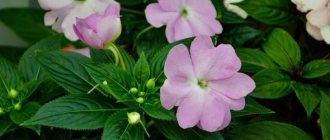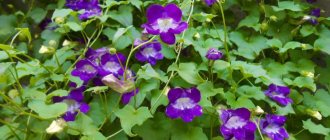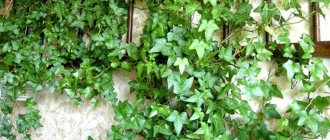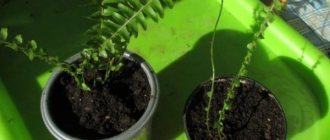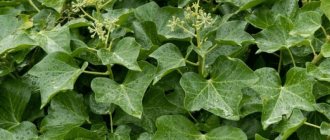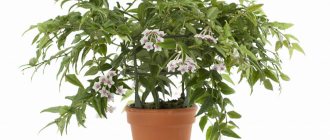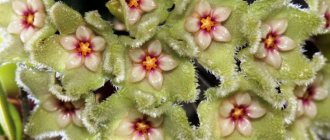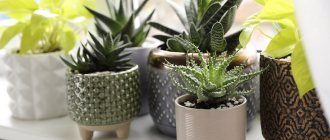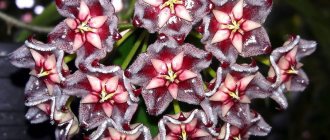Numerous types of vines are in demand and popular in landscape design, and the variety of types and varieties of garden ivy is best suited for decorating a site, especially in the English style.
Varieties such as Thorndale and Modern Times are fast growing. Their use in vertical plantings allows you to completely cover a fairly large surface.
Clinging to the walls of the facades of buildings, they create magnificent carpets of green foliage. In addition, ivy is often used as ground cover, simply letting the vine climb along the ground.
There are several forms of these climbing perennials that form lush bushes. Moreover, they can be used both in vertical gardening and when grown in pots.
These varieties include Hibernica, Duckfoot, and the variegated Profesor seneta. They are able to develop quite quickly and form dense continuous hedges up to 2 m high, decorate tree trunks, decorate walls and fences.
Garden ivy variegated
Compact species are perfect for growing on alpine hills. Leaves of various shapes and colors will decorate any corner of the garden and give it a special unique style, for example, Goldheart, Profesor seneta, Golden Kolibri.
Variety Goldheart
Common ivy is often used as a lawn replacement. Growing freely in the soil without support, the plant is capable of creating continuous, dense carpets.
Variety Hibernica
You can create shapes from ivy by making a small support for them in the form of a ball or cone, along which the compact plant can curl.
Description of garden ivy (Hedera)
This type is the most common due to its increased resistance to cold and unpretentiousness. Ivy can be grown as a houseplant, but it also looks great in the garden.
Decorating the inside of the house with ivy shoots
Garden ivy - evergreen and frost-resistant
Winter-hardy common ivy is popular in Russia. The first two years mark slow growth. The plant is used as a ground cover crop and for landscaping vertical structures.
For your information! Ivy prefers partial shade without wind.
Characteristics of garden evergreen ivy
The shoots of a climbing vine can reach 30 m. It is firmly attached to a vertical wall or tree due to its sucker roots.
In total there are 15 types of ivy and over 1000 varieties. The leaves may vary in color, size and shape depending on the variety.
Variegated species are given a certain decorativeness by the white border of the leaves, dark or light inclusions in comparison with the main background. The leaves are dense to the touch with a smooth surface. October and September are considered the flowering period of the plant. Light green inflorescences in the shape of umbrellas.
Important! The fruits of the flower are poisonous; they look like black peas with a blue tint.
Types of ivy for the garden
Useful properties of ivy
Ivy is used not only as an ornamental plant, but also as a medicinal plant. In folk medicine, it is added to tinctures, decoctions are made to relieve coughs, and is recommended for decreased immunity and liver diseases. The flower is believed to have the following properties:
- antibacterial;
- diuretic;
- anti-inflammatory;
- acceleration of wound healing.
Important! It is recommended to use ivy folk remedies externally and only for adults. At the same time, treatment with official medicine and other doctor’s prescriptions should not be neglected.
Thanks to its lush crown of foliage, ivy also has a beneficial effect on the atmosphere in the room. The plant acts as a sorbent, trapping vapors from tobacco smoke, chemicals, and toxic fumes from walls and furniture.
Esotericists give ivy the ability to absorb negative energy. If you put a flower in the nursery, hyperactive kids will be calmer. In the living room, the hedera will protect the owners from the negative influence of unwanted guests.
Popular types and varieties
How indoor ivy or hedera propagates
The plant is a heat-loving crop, so it is most often found in the south. Some frost-resistant vines grow in temperate climates. Here are the main types of ivy:
- ordinary. This is the most common plant that is used for planting outdoors and indoors. The leaves are medium-sized and have a five- or three-fingered shape. Depending on the variety, the foliage may have blotches or shine. Growth is moderate, reaching up to 20 m in length, weaving around nearby surfaces. Ivy is used for vertical gardening of structures and buildings. It is better to plant in partial shade. The most popular frost-resistant varieties are Goldhert, Mona Lisa, Eva, Sagittaefolia;
- Caucasian, or Colchian. This is a fast-growing plant species characterized by large dark green leaves and strong shoots. The liana is capable of weaving a surface up to 30 m high and grows in the shade. Popular garden forms - Dentata Variegata, Arborescens;
- Crimean. Ivy is unpretentious, grows quickly, and is resistant to cold and drought. As it grows, there is a lignification of the shoots that wrap around shrubs and trees. The length of an adult vine reaches up to 30 m, and the trunk in circumference is up to 1 m.
Each type has its own characteristics and features, but they are ideal for garden landscaping.
Signs and superstitions
There is a fairly strong belief that ivy in a house is an energy vampire that can bring misfortune to all its inhabitants and doom women to loneliness. This houseplant is even sometimes called a “husband buster,” supposedly because it can destroy the relationships of loved ones, so some believe that it should not be kept in the house.
The nature of these superstitions is not entirely clear, because the ancient Romans and Greeks, on the contrary, were convinced that ivy was a guarantee of a happy marriage and male fidelity.
The problem interested psychoanalysts, who made the following conclusion: ivy is capable of absorbing (like many of our other green helpers) tobacco smoke, substances toxic to humans emitted by varnished furniture, any “chemistry”, for example, fumes from aerosols, household drugs, but in addition to all this, it can absorb bursts of aggressive energy.
This amazing ability distinguishes ivy from many other representatives of domestic flora and gives rise to various superstitions. This quality, according to experts, can be used for “peaceful purposes” by placing the flower in a room where there are hyperactive children - home ivy will act as a sedative, or keep it in a room where not the most pleasant guests often drop in to neutralize that negativity which they will bring with them.
Ivy care
Common indoor variegated ivy flower
The wind carries whiteflies, mites, aphids, and thrips that are dangerous to ivy. Insecticides must be used immediately as soon as pests are noticed on leaves and stems.
Note! Diseases and parasites can be recognized by yellowed, pale or fallen leaves.
Sometimes it is necessary to repeat the procedure for getting rid of pests.
Propagation of ivy by cuttings
It is recommended to use apical cuttings that can multiply quickly. To grow a seedling you need:
- Cut cuttings up to 10 cm long that have at least one healthy node.
- Plant in a pot or root in loose soil in a greenhouse, water.
- Replant the ivy to a permanent location when a sufficient number of roots have formed.
For your information! Cuttings from a young plant take root poorly and sometimes even rot.
Preparing for winter
Low temperatures can have a detrimental effect on the plant, especially in the middle zone. Covering the soil with an additional layer of mulch will help protect the vine. In winter, it is recommended to sprinkle snow up to 30 cm high on the soil. Experienced gardeners cover lashes that grow vertically with polyethylene or burlap.
Important! In early spring, the top layer of covering should be removed to avoid damage to the stems due to high humidity and temperature.
Planting an outdoor plant in a pot
Botanical description
Common ivy is an evergreen climbing shrub that is capable of attaching its sucker-shaped adventitious roots to various objects (trees, house walls, hedges, etc.), using them as a support. It can reach 20-30 m in height and also grow as a ground cover plant. Considered a weed in many regions, it grows in a wide range of soil pH, but an acidity of 6.5 is ideal for it. Prefers moist, shaded places and avoids exposure to direct sunlight.
The leaves are alternate, leathery, smooth, 50-100 mm in length, petiole 10-20 mm.
Ivy has two types of leaves:
- adults are fan-shaped, with five lobes;
- young ones - with three lobes on creeping stems and heart-shaped on fruiting, flowering shoots that are open to the sun and usually crown the crown.
The flowers are small, greenish-yellow, have no decorative value, and appear from late summer to autumn. They are a good source of nectar for bees. The fruits are purple-black, ripen in winter and are included in the diet of many birds, but are poisonous to humans.
22
Possible problems in growing garden evergreen ivy in open ground
When growing a plant, the greatest dangers are thrips, whiteflies, aphids, mites and insects that are carried by the wind. When pests appear on leaves or stems, you must immediately begin treating perennial outdoor ivy with insecticides. The liana should be sprayed with karbofos or actellik diluted in water. Sometimes several irrigations are required to completely eliminate parasites.
Hedera helix mix or common ivy - home care
The affected areas must be removed so that the infection does not spread to the stems and leaves that are nearby.
Violation of care rules
There are several signs by which you can find out about the presence of pests or diseases:
- yellow and dry leaves indicate excess fertilizer and humidity;
- the pallor of the plant indicates a lack of ultraviolet rays, so it should be transplanted from the shade to an area with good lighting;
- yellow foliage signals dry soil, so you need to control watering;
- Dry air causes leaves to fall off; spraying with water from a hose will eliminate the problem.
Important! When parasites appear on a vine, it is necessary to inspect all nearby crops.
How to recognize diseases and notice pests. Combination with other plants
Ivy is considered an unpretentious plant, but it can get sick or be captured by pests at any moment. It is important to promptly recognize that the plant needs help and take all measures to cure it.
Advice. If the ivy is attacked by pests or disease, it is necessary to inspect all nearby crops.
- If the leaves begin to turn yellow and fall off, the cause must be sought in dry soil. Having received sufficient watering, very soon the ivy will acquire new foliage.
- If the stems lose their green leaves and quickly become bald, the ivy does not like the air. Typically, this phenomenon can occur in hot summer or autumn. Therefore, the gardener is recommended to give his plant water treatments every day.
- It’s a bad sign if the variegated and bright green leaves suddenly fade. The root cause is that the plant receives little light. The problem can only be solved by planting in a new, more illuminated place.
Ivy growing in open ground cannot be protected from pest attacks. Aphids, scale insects, and mites are carried by insects and wind. If you find parasites on the leaves or stems, you should immediately begin the fight. To overcome them, it is necessary to spray ivy and all nearby crops with actellik diluted with water or karbofos. After the first spraying, it may not be possible to completely get rid of pests. In this case, the procedure should be repeated after a few days.
Ivy will perfectly decorate hedges
This plant is often planted near the fence, near the house, around gazebos. Photos of buildings overgrown with ivy can be seen in magazines. Ivy, if you guide the branches along supports as it grows, will become a worthy decoration for your garden plot. It is not afraid of any neighbors growing nearby, but not all plants are compatible with ivy and can coexist with it in the same area.
Coniferous, deciduous trees and ornamental shrubs will be comfortable next to ivy. Landscape designers present the idea of a combination and recommend planting this creeping plant in a garden with roses. Dark or variegated ivy greens will beautifully highlight the base of the queen of flowers.
Garden ivy, when it grows and gains strength, becomes very beautiful. When starting such a plant, you should be prepared that in order to give it a neat, aesthetic shape, the plant needs to be pruned regularly. Especially if it stretches up along supports, walls of the house, or fences. Otherwise, caring for the plant is simple. By choosing the right place on the site, organizing watering, timely fertilizing and testing the propagation of the plant in practice, within a season you can become the owner of incredibly beautiful garden ivy.
How to plant street ivy
Planting an outdoor plant is slightly different from an indoor one. You need to know all the nuances of caring for and propagating evergreen vines before planting ivy at home.
Preparation and planting of purchased planting material
Seedlings are planted at a distance of 50 cm from each other to facilitate future care. The ivy root and drainage should be placed in the hole. When planting, the soil is compacted and moistened abundantly. Air must flow to the rhizome, so it is necessary to control the condition of the top layer of soil. It can be loosened or covered with peat, sawdust, leaves, etc.
Conditions for ivy propagation
Landscaping the area with a climbing plant is not difficult if you immediately purchase new seedlings. But the garden vine can be propagated independently, although the task is not very simple. The main thing is to choose the best method and follow all transplant rules.
The main methods of propagating plants that grow in open ground near the house or in the country:
- rooting of cuttings;
- cuttings;
- division of perennial shrubs.
Old ivy can be separated and there is no need to completely dig it up. Part of the vine should be removed around the perimeter, using these branches as independent seedlings.
Reproduction by cuttings
Cuttings are the main method of ivy propagation.
The twigs of a houseplant take root quickly, so plain water is often used. For garden vines, different methods are used, but cuttings remain the main one. The ivy vines begin to take root within a few weeks.
It is recommended to use annual shoots; stem and apical cuttings are suitable. The first require the separation of an entire shoot with 8-10 leaves. Select not too small apical cuttings, 10-20 cm long, which must be cut at an angle. The two lower pairs of leaves are cut off.
Plant cuttings can be rooted in:
- mixtures of sand and peat;
- water;
- soil with a high sand content;
- solution of rooting stimulants.
Note! For the procedure, different containers, greenhouses and even mini-greenhouses in the open air are used.
It is not necessary to cover the ivy and create conditions with optimal temperature conditions. The main thing is to keep the soil consistently moist. Covering with a cap slightly speeds up rooting; the same effect can be achieved by using growth stimulants.
The apical cuttings need to be planted in the ground, deepening them to the first leaves. The average rooting period is 2-6 weeks, after which the vine can be transplanted to a permanent location.
Stem cuttings are laid horizontally on the soil surface. The shoots need to be pressed to a depth of 2 cm, leaving the leaves on top. Basically, the stem is left whole, but it can be divided into cuttings with a single leaf node. Rooting time is 2 weeks, after which the tip of the shoot begins to grow rapidly. Plants should be separated only after 2 weeks.
For your information! It is better not to immediately transfer rooted cuttings to a permanent place; it is recommended to use a separate bed or container for growing. The final transplant is carried out in early autumn or late summer, but the best time is the beginning of spring. During this period, the plant will grow a rhizome and will be protected from frost.
Rooting cuttings of ivy
The plant can be propagated by layering, like other types of climbing vines. Scourges located on the ground are able to take root on their own. To obtain strong stems, this process can be stimulated. Rooting cuttings is a very popular method of propagation and is ideal for those who want several new plants.
Even for novice flower growers, the procedure will seem simple:
- In a small trench it is necessary to place the lower shoots of variegated garden ivy for vertically growing plants or along the perimeter for horizontally growing plants. Strong and long shoots are used for propagation. To speed up rooting, it is necessary to make cuts on the branches.
- The branches are secured in the ground with staples, sprinkled with a nutrient mixture or substrate on top.
- Stable humidity will be maintained by abundant watering at first, and then regular moistening.
There is no need to rush to plant new stems after rooting. Next spring, you can separate the new shoots as an independent plant and plant them in a permanent place.
Preparing for planting in open ground
It is recommended to plant the plant in an elevated place without wind. It is necessary to avoid a completely open area, because the leaves can get burned from direct ultraviolet rays. It is better to choose partial shade.
Evergreen liana in the country
Next is to prepare the ground. The soil must be breathable and moist.
When purchasing an already grown seedling, you need to pay attention to its condition. A healthy plant has a developed root system.
Important! It is not recommended to plant the plant on clay soil because the roots will not receive enough oxygen.
Reproduction and transplantation of ivy
Before planting indoor ivy, you need to prepare a mixture favorable for growth, which will include:
- 2 parts leaf humus;
- 2 parts turf soil;
- 1 - sifted sand.
The ivy pot must be selected in accordance with the requirements of sufficient width and shallow depth. Replanting should be done in the spring, when young root shoots break through the holes in the bottom. The first layer of drainage is placed in the flowerpot, then the prepared soil mixture is poured. The ivy plant, like any plant crop, needs feeding. The best option for fertilizing it is a mineral complex for indoor deciduous flowers. To prevent the leaves from growing too large under the influence of such procedures, you need to fertilize the soil in moderation.
The flower is propagated by various methods:
- shoots, immersing them in the ground located in the pot where the mother plant grows.
- cuttings, planting them at a thermometer reading of +23°.
- separation of ivy shoots, and subsequent rooting into the ground.
Ivy in the country
The best shrubs and trees are always planted on a summer cottage. A climbing vine will decorate a place that is used for relaxation.
How to plant ivy on a plot
Many gardeners are interested in how to grow variegated garden ivy. It is better to plant cuttings in spring in breathable and nutritious soil to a depth of 15-20 cm.
Note! If the soil is heavy, you need to dig a hole a little deeper and make drainage from expanded clay or broken bricks.
The young plant should be directed towards a support or fence. Watering is carried out moderately so that there is no stagnation of water. You can fertilize the vine with organic fertilizer once a month. Before winter, shoots should be covered to prevent frostbite of the stems and roots.
Use in landscape design
Evergreen vines attract attention due to the variety of colors and shapes of the leaves. Designers use the plant to decorate vertical surfaces:
- sculptures;
- house walls;
- arches
Note! When creating a structure, it is necessary to constantly direct the growing shoots in the right direction.
Combination with other plants
Common garden ivy can be combined with other plants that can embody any design ideas. The liana is planted near roses, flowering shrubs and coniferous trees. As a result, the gardener gets ivy climbing along the wall, which is pleasing to the eye.
How to prevent the growth of garden evergreen ivy
Gardeners are not always happy about the intensive growth of the plant, which begins to entwine nearby trees and bushes. To get rid of ivy, you need to cut it off at the very root, dig up the entire root system and make sure that there are no shoots left on the ground. Sometimes herbicides are used.
Following the rules of care, planting and propagation will allow you to achieve good results. Evergreen ivy will grow quickly and beautifully. With the help of the plant, they create an original landscape design, decorating hedges, other shrubs and even the walls of the house with greenery.
Garden design
Ivy is widely used in landscaping the interiors of residential and office premises, gardens, parks, and personal plots. When skillfully combined with wood, ceramics, and other plants, magnificent compositions are obtained.
The great advantage of ivy over other groups of plants is the possibility of their vertical placement, which saves planted area.
The climbing plant ivy is able to conquer the walls of a house without additional supports. This root-climbing plant has difficulty climbing only on smooth glass and metal vertical surfaces.
White or very light surfaces that strongly reflect the sun's rays can also harm it. Two or three ivy plants can quickly create a large mass of greenery, which will protect in summer from direct sunlight and overheating, and in winter, the walls of houses from excessive heat transfer.
When planting ivy in a dacha as a ground cover plant, it can get along with trees such as maple and birch, which have a highly developed superficial root system and therefore usually have no neighbors.
Since common ivy can only overwinter under snow cover, all shoots above it are frozen. Therefore, it cannot be used to create a solid green wall or cropped figures. It is suitable for creating low borders, which, if necessary, can be covered for the winter.
Common ivy combines successfully with shrubs, perennials, and forms an excellent pair with standard roses. The reddish color that ivy acquires in early spring and late autumn complements snowdrops and primroses well.
Garden ivy is used to decorate external hedges, dividing fences within a site, and beautifully frame a gazebo or pool.
This ivy in the garden grows quickly and luxuriantly in a very short time, so it can be used to improve an old stone fence, unsightly walls or the facade of a building. Brightly flowering bushes look good against the backdrop of a garden ivy hedge.
A hedge is a great way to demarcate an area.
Benefits of a green ivy fence
Garden ivy, as an option for hedges, has a number of advantages:
- This plant has pleasant relaxing properties. Unraveling, it creates a thick green wall that is a pleasure to admire.
- The aesthetic and decorative properties of a hedge cannot be compared with a metal, wooden or brick fence.
- The versatility of this plant lies in the fact that the shape can always be adjusted by pruning.
- Ivy perfectly decorates unsightly buildings on the site, gazebos, and also hides cozy places in the garden, house, and windows from prying eyes.
- Garden ivy is an evergreen plant. Therefore, fencing made from it perfectly retains its decorative properties in winter and summer.
- To form a green ivy fence, you do not need large financial investments.
Types of ivy for green fencing
Ivy is a woody evergreen vine. Among the many varieties, the garden variety of this plant grows and develops well in temperate climates. In landscape design, only two subspecies are used: ordinary and Colchis.
Ivy
Common ivy is characterized by moderate growth. But its foliage has special decorative properties. Shiny leaves can come in a variety of shapes. Therefore, it will not be difficult for any gardener, even the most demanding one, to choose a beautiful plant for his plot.
Colchis ivy grows very quickly. Its long shoots with large foliage will quickly weave the place prepared for this.
Colchis ivy
Both common ivy and Colchis ivy are blooming. However, their flowers are of no decorative value. But the inedible berries that appear after flowering add a special charm to the hedge.
Although all types of this plant prefer shaded areas, varieties with variegated leaves must receive enough sunlight, otherwise they will acquire a normal green color over time.
Three propagation methods are used for garden ivy:
- Cuttings.
- Rooting cuttings.
- Dividing old bushes.
Old, overgrown ivy that has turned into entire colonies, some of the shoots of which have taken root and sprouted, can be divided. It is not necessary to dig up the entire plant for this: it is enough to separate some of the plants around the perimeter and use them as independent seedlings.
With any reproduction method, you should adhere to the general rules:
- For rooting both cuttings and layering of ivy, annual or, in extreme cases, biennial shoots are chosen.
- When choosing branches, it is worth examining them carefully: semi-lignified, strong shoots with visible aerial roots or their rudiments give results faster than very young branches.
- It is best to propagate ivy in spring or the first half of summer.
Young ivy obtained independently can be planted in a permanent place in early autumn and spring. For the middle zone, spring planting is preferable, because in this case there is much less risk of losing plants in the event of extreme weather, and there is more time for adaptation before the first wintering.
Rooting ivy cuttings in water. © Jen
